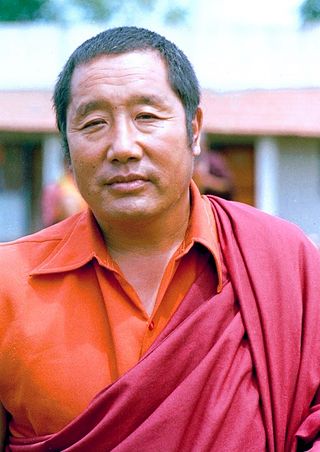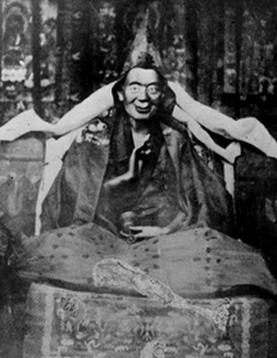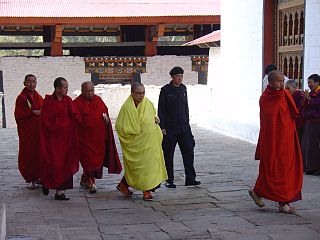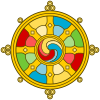A tulku is a distinctive and significant aspect of Tibetan Buddhism, embodying the concept of enlightened beings taking corporeal forms to continue the lineage of specific teachings. The term "tulku" has its origins in the Tibetan word "sprul sku", which originally referred to an emperor or ruler taking human form on Earth, signifying a divine incarnation. Over time, this term evolved within Tibetan Buddhism to denote the corporeal existence of highly accomplished Buddhist masters whose purpose is to ensure the preservation and transmission of a particular lineage.

Chöje Akong Tulku Rinpoche was a tulku in the Kagyu school of Tibetan Buddhism and co-founder of the Samye Ling Monastery in Scotland, Tara Rokpa Therapy & ROKPA International Charity.

Jamgön Kongtrül Lodrö Thayé, also known as Jamgön Kongtrül the Great, was a Tibetan Buddhist scholar, poet, artist, physician, tertön and polymath. He is credited as one of the founders of the Rimé movement (non-sectarian), compiling what is known as the "Five Great Treasuries". He achieved great renown as a scholar and writer, especially among the Nyingma and Kagyu lineages and composed over 90 volumes of Buddhist writing, including his magnum opus, The Treasury of Knowledge.

Zhabdrung was a title used when referring to or addressing great lamas in Tibet, particularly those who held a hereditary lineage. In Bhutan the title almost always refers to Ngawang Namgyal (1594–1651), the founder of the Bhutanese state, or one of his successive reincarnations.
Surmang refers to a vast alpine nomadic and farming region, historically a duchy under the King of Nangchen, with vast land holdings spreading over what is today the Tibet Autonomous Region and Qinghai Province. In Tibetan the King of Nangchen's realm was called the "nyishu dza nga" or the 21 (provinces). Since 1959 it is mainly within the Yushu Tibetan Autonomous Prefecture of Qinghai province in China. Yushu Prefecture is 97% ethnic Tibetan. The Surmang region is one of the poorest regions in China ranking it among the world's highest infant and maternal mortality, almost 100% illiteracy, and personal income of less than US 14¢/day. It is part of the catchment in China of the 30 million ultra-poor.

Chatral Sangye Dorje Rinpoche was a Tibetan Dzogchen master and a reclusive ngagpa yogi, known for his great realization and strict discipline. Chatral Sangye Dorje was a disciple of Khenpo Ngawang Pelzang and was widely regarded as one of the most highly realized Dzogchen yogis. In addition to his relationship with Khenpo Ngagchung, Chatral Sangye Dorje also studied with some of the last century's most renowned masters, including Dudjom Jigdral Yeshe Dorje, Dzongsar Khyentse Chökyi Lodrö, and the famed Kunzang Dekyong Wangmo. Chatral Sangye Dorje was one of the primary lineage holders of the Longchen Nyingthig, and in particular the lineage that descends through Jigme Lingpa's heart son Jigme Gyalwe Nyugu and then on to Patrul Rinpoche.

Kyabjé 3rd Drubwang Padma Norbu, Lekshe Chokyi Drayang widely known as Penor Rinpoche, is the 11th throneholder of the Palyul Lineage of the Nyingma school of Tibetan Buddhism, and the 3rd Drubwang Padma Norbu. He is recognized as the incarnation of Vimalamitra, an 8th century Buddhist Monk. By the age of 17, he had received the corpus of Payul lineage teachings including Dzogchen teachings, and became a renowned Dzogchen master. He began his escape from Tibet in 1959 with 300 people, and only 30 arrived in India. While working alongside laborers, he rebuilt Palyul Monastery in Karnataka, India, where more than 5,000 Nyingma school monks and nuns study.

Gaden Tharpa Choling Monastery is a Gelugpa monastery situated at the top of Tirpa hills in Kalimpong, India. The monastery was founded by Domo Geshe Rinpoche Ngawang Kalsang in 1912.

Old Ghoom Monastery is the popular name of Yiga Choeling. The monastery belongs to the Gelukpa or the Yellow Hat sect and is known for its 15 feet (4.6 m)-high statue of the Maitreya Buddha. The external structure of the building was established in 1850 by the Mongolian astrologer and monk Sokpo Sherab Gyatso, who was head of the monastery until 1905.
Chote Chaba was a Tibetan lama, the 12th incarnation of the Migyur Khutughtu, and the 18th king of Muli. At the time, Muli was a small princely state on the border between Tibetan and Han Chinese civilisation; it now forms the Muli Tibetan Autonomous County in southwestern Sichuan province.

Patrul Rinpoche (1808–1887) was a teacher and author from the Nyingma school of Tibetan Buddhism.
The Khamtrul tulku lineage is part of the Dongyud Palden section of the Drukpa Lineage of the Kagyu school of Tibetan Buddhism.

Ngawang Lekshey Gyaltso is the 15th in the lineage of Changling Rinpoches. His lineage was started by Rechung Dorje Drakpa, who lived in eleventh century Tibet.
Khenpo Ngawang Palzang, also known as Khenpo Ngagchung, is considered by the Tibetan tradition to be an emanation of Vimalamitra.
Tsoknyi Rinpoche or Ngawang Tsoknyi Gyatso is a Tibetan Buddhist teacher and author, and the founder of the Pundarika Foundation. He is the third Tsoknyi Rinpoche, having been recognized by the 16th Karmapa as the reincarnation of Drubwang Tsoknyi Rinpoche. He is a tulku of the Drukpa Kagyü and Nyingma traditions and the holder of the Ratna Lingpa and Tsoknyi lineages.

Domo Geshe Rinpoche is said to have been Shariputra, the Mahadsiddha Gayadhara, Dharmashri, Munijnana, Tönmi Sambhota, King Trisong Detsen, Dromtönpa, Milarepa, Khedrup Rinpoche, and Dragpa Gyaltsen in previous lives.

Geshe Rabten (1921–1986) was a Tibetan geshe born in Tibet.

Tulku Jigme Chhoeda became the 70th Je Khenpo of Bhutan in 1996, and became the longest-serving holder of the office.












